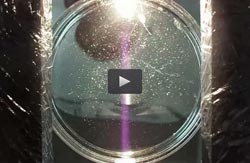Researchers find the macroscopic Brownian motion phenomena of self-powered liquid metal motors

This video shows hydrogen bubble tails generated from a swarm of self-powered liquid metal tiny motors which were distinguished through high contrast optical images. It indicates that these tiny motors kept swiftly traveling here and there, just like a fairy. Credit: ©Science China Press
Ever since the irregular motions of suspended grains in water was observed by Brown in 1827, tremendous efforts have been made on establishing a theory to characterize the Brownian motion. After almost a half century later, the kinetic theories of heat developed by Maxwell, Boltzmann and others were merging as a possible explanation.
In 1905, Einstein published a theoretical paper interpreting the stochastic process using particle diffusion constant and the fluid viscosity. This relationship bridges the microscopic dynamics with the macroscopic phenomenon, which inspired many subsequent works regarding both thermodynamics and statistical physics. Such theory was later demonstrated by the well-known Perrin's experiments.
So far, most of the classical Brownian motions refer to the molecules activities that occur in microscale. There are very limited reports to investigate such phenomena in macroscale. And the ever tackled phenomena are mainly focused on the particle motions caused by the surrounding liquid molecules.
In this study, researchers disclosed that macroscopic liquid metal motors in millimeter scale showed similar Brownian motion behavior in alkaline solution. The authors dispersed the premixed liquid metal and Al (mass percentage 1%) alloy into a glass Petri dish. It was observed that each tiny motor in millimeter scale began to move swiftly and randomly on Petri dish glass.
Contrary to the classical Brownian motion behavior, the main driving force of such motion comes from the hydrogen bubbles generated at the bottom of the tiny motors. Such tiny motor differs in moving mechanism with its counterpart large size self-fueled liquid metal machine which was mainly driven by the electrochemically induced surface tension.
Further, an optical platform with high image contrast, which works somewhat like the Wilson Cloud Chamber, was introduced to clearly depict the hydrogen bubble stream left behind the running motors.
The present findings add important new knowledge to the liquid metal motor as well as the classical Brownian motion phenomenon. The established optical image contrast method also provides an important experimental tool for further investigations along this direction.
###
This research was partially supported by the Research Funding of the Chinese Academy of Sciences (No. KGZD-EW-T04-4).
See the article:
B. Yuan, S. Tan, Y. Zhou, J. Liu, “Self-powered macroscopic Brownian motion of spontaneously running liquid metal motors,” Sci. Bull. (2015) 60(13):1203-1210. http://link.
Media Contact
All latest news from the category: Physics and Astronomy
This area deals with the fundamental laws and building blocks of nature and how they interact, the properties and the behavior of matter, and research into space and time and their structures.
innovations-report provides in-depth reports and articles on subjects such as astrophysics, laser technologies, nuclear, quantum, particle and solid-state physics, nanotechnologies, planetary research and findings (Mars, Venus) and developments related to the Hubble Telescope.
Newest articles

After 25 years, researchers uncover genetic cause of rare neurological disease
Some families call it a trial of faith. Others just call it a curse. The progressive neurological disease known as spinocerebellar ataxia 4 (SCA4) is a rare condition, but its…

Lower dose of mpox vaccine is safe
… and generates six-week antibody response equivalent to standard regimen. Study highlights need for defined markers of mpox immunity to inform public health use. A dose-sparing intradermal mpox vaccination regimen…

Efficient, sustainable and cost-effective hybrid energy storage system for modern power grids
EU project HyFlow: Over three years of research, the consortium of the EU project HyFlow has successfully developed a highly efficient, sustainable, and cost-effective hybrid energy storage system (HESS) that…





















